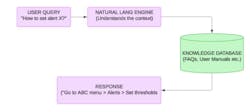How Do You Build a Chatbot for Knowledge Transfer?
Manufacturing is no stranger to automation. From robotic arms to predictive maintenance, the factory floor has been transformed. But there’s one area still heavily reliant on manual, human-driven processes: knowledge transfer.
When experienced employees leave, they often take decades of application-specific knowledge with them, leaving behind gaps in productivity, confidence and efficiency. New employees struggle to get up to speed, and the seasoned employees who remain are stretched, answering repetitive questions.
To solve this issue, I created a prototype knowledge automation bot. This AI assistant helps employees with enterprise software and procedures. It's part of a digital transformation initiative to improve technology, streamline processes and boost efficiency in manufacturing.
The solution is simple but powerful: Instead of digging through manuals, chasing down colleagues or submitting IT tickets, employees can now just ask a question and get an instant, accurate answer.
Origin of the Idea
The idea didn’t come from a brainstorm discussion but from the real shop floor, from seeing the frustration of new hires struggling with unfamiliar systems and the pressure on tenured staff constantly being interrupted to explain “how to do this in the system.”
I asked myself: What if there was a way to preserve expert knowledge and make it instantly available to anyone who needs it, anytime? This led to a knowledge assistant, capable of answering application-specific questions 24/7, in plain English across departments.
How Does It Work?
The knowledge bot is an AI-powered virtual agent capable of understanding natural language queries and responding with accurate, context-aware guidance taken from the organization’s internal documentation, application manuals and FAQs. The key components include:
Natural language understanding (NLU): To enable the bot to interpret complex, context-rich human queries accurately.
Knowledge base integration: To make the bot search through a knowledge hub of application knowledge, documentation and FAQs.
Response generation: To enable the bot to provide accurate, concise and conversational responses to the user’s questions.
Continuous learning: To train the bot to improve its responses with every interaction, learn new terms and adapt to user behavior.
This shows a fundamental change from passive documentation to active, AI-driven knowledge delivery that is always accessible.
Impact on Manufacturers
This is not just about cool or cutting-edge tech. It’s about solving very real challenges that affect performance, cost and workforce morale.
Knowledge stays when employees leave. When a senior staff member retires, their expertise is preserved in the bot for everyone to access.
New employees can quickly become productive, executing tasks independently within days instead of taking 4-6 weeks to learn our ERP or MES system.
The bot addresses routine queries promptly, reducing IT workload and minimizing downtime caused by application confusion, leading to fewer helpdesk tickets and increased productivity.
It’s possible to achieve high ROI without expensive hardware or extensive rollout. Start small, scale gradually, and see results in weeks.
Implementation details
During prototype testing, we took the following steps to implement and validate the agent's performance:
- Identified a high traffic module or area
- Built a knowledge base with a set of documents, manuals and FAQs
- Integrated the knowledge base with the chatbot (like training the LLM engine)
- Set up a set of pre-defined questions and answers for regular and common conversations
- Designed a front-end interface (a web portal) like a chat window
- Tested with a group of three to five users for three weeks
- Assessed the responses, accuracy and usefulness
Some metrics collected (from initial trials) include:
Other parameters can be tracked during extended use, such as:
- Waiting time (or dependency) for a senior staff member for clarification
- Documentation-related email traffic
- Reduction time in terms of support ticket logging/resolving etc.
Challenges, Limitations and Troubleshooting
One major challenge we faced was in structuring the knowledge base. While we had a huge set of process documents, operating procedures and help desk logs, much of it was scattered, not updated or written in technical terms. We had to spend time curating and cleaning this content, converting the raw knowledge into a format the bot could understand and reliably retrieve.
Another challenge was managing expectations. Some users expected the bot to behave like a human expert from day one. In reality, early versions of the bot required iterative tuning and training to improve its accuracy and contextual understanding.
What the Bot Answers Well vs. What It Doesn’t (Yet)
The bot does a good job when answering well-documented, repeatable questions that are procedural, consistent and based on static documentation, which is perfect for automation. However, for questions involving complex judgment, real-time context or exceptions, human intervention is still best.
For example, “Why did this job fail today?” or “This screen is showing an unusual error. What should I do now?” In such cases, the bot may offer a general guideline or will direct to a human expert, either by flagging the issue or redirecting the user to a specific subject-matter expert or support team.
Handling Incompleteness or Incorrect Answers
Yes, like any AI system, the bot can sometimes give incomplete or confusing answers, especially if the given source material is outdated or ambiguous. We set up a feedback mechanism allowing users to report such responses. These are reviewed regularly by a designated team, who either retrain the bot with better examples or update the content in the knowledge base. To reduce the confusion or until we get confidence, we limited the bot’s domain to specific topics (application usage) and we added disclaimers where confidence is low.
Over time, through usage and refinement, the bot learns what works and what doesn’t, improving its functions while maintaining its designated role.
About the Author
Rajkumar Chindanuru
Rajkumar Chindanuru is a business applications engineer with over 20 years of IT experience in designing, developing and implementing software solutions. He holds a master's degree in computer applications. His work focuses on developing, modernizing and transforming legacy applications, as well as AI-driven solutions to enhance operational efficiency and support business growth. Rajkumar has collaborated with companies in various sectors, including retail, manufacturing, banking, logistics, and hospitality. Currently, he works for a U.S. retailer that also owns a manufacturing entity, where he provides application support and engineering.


